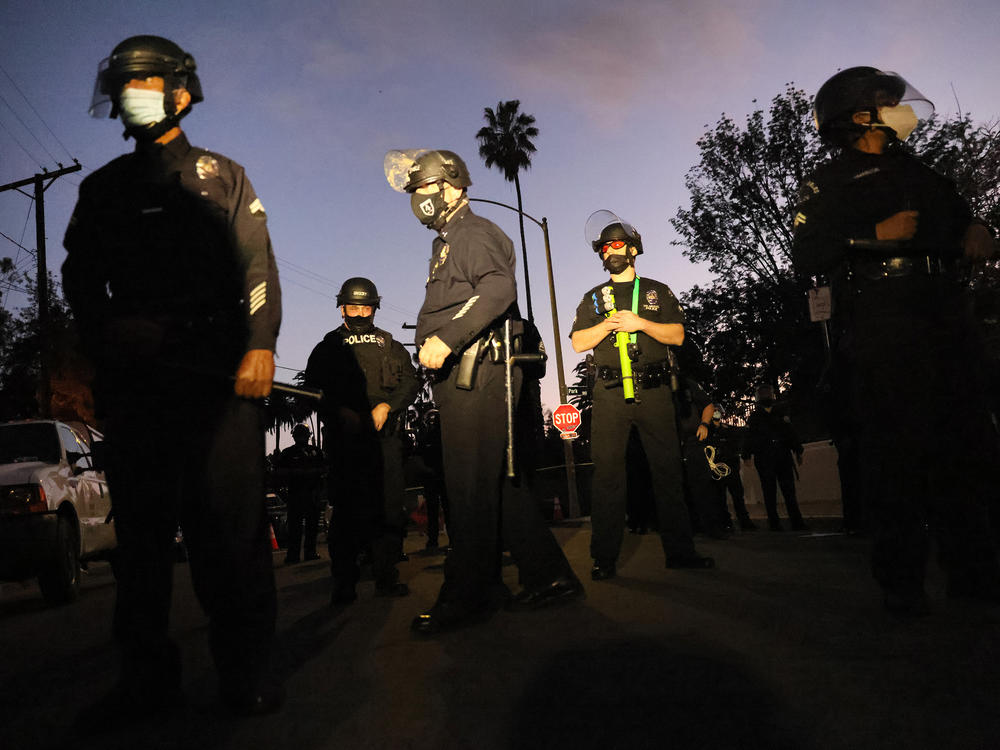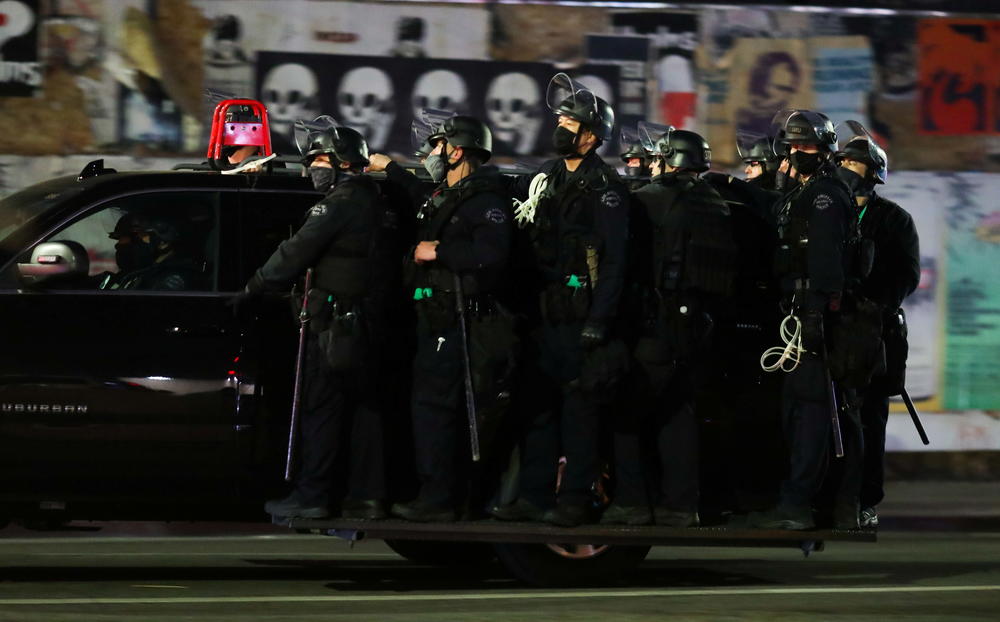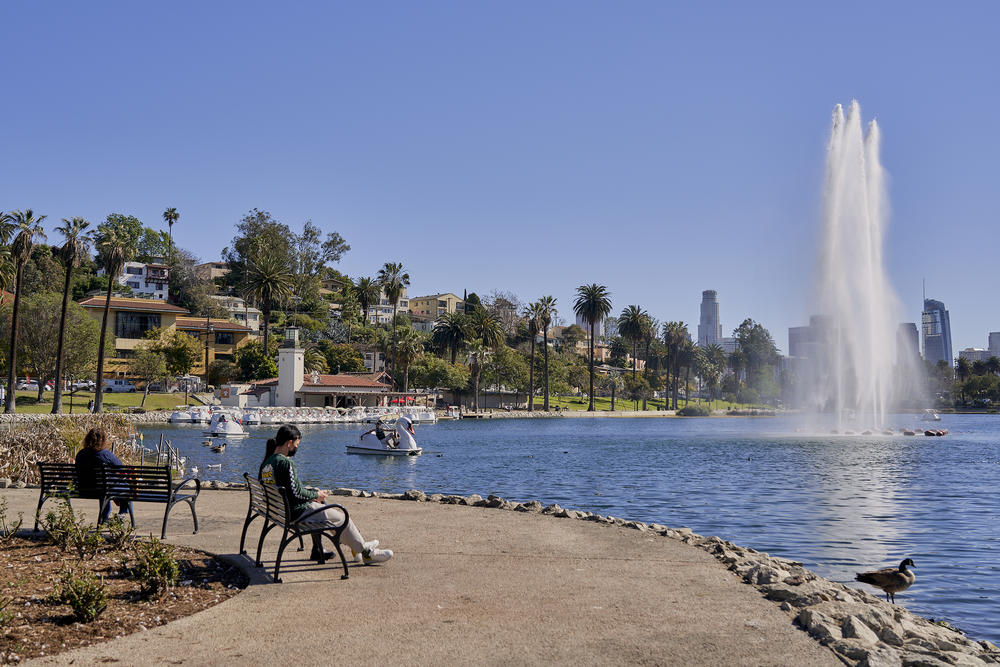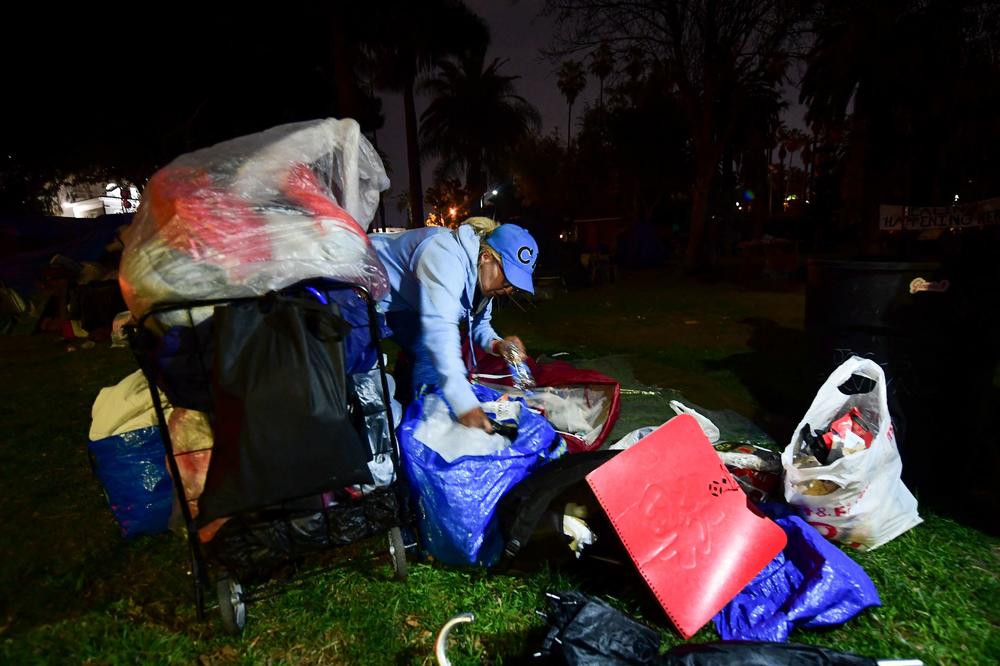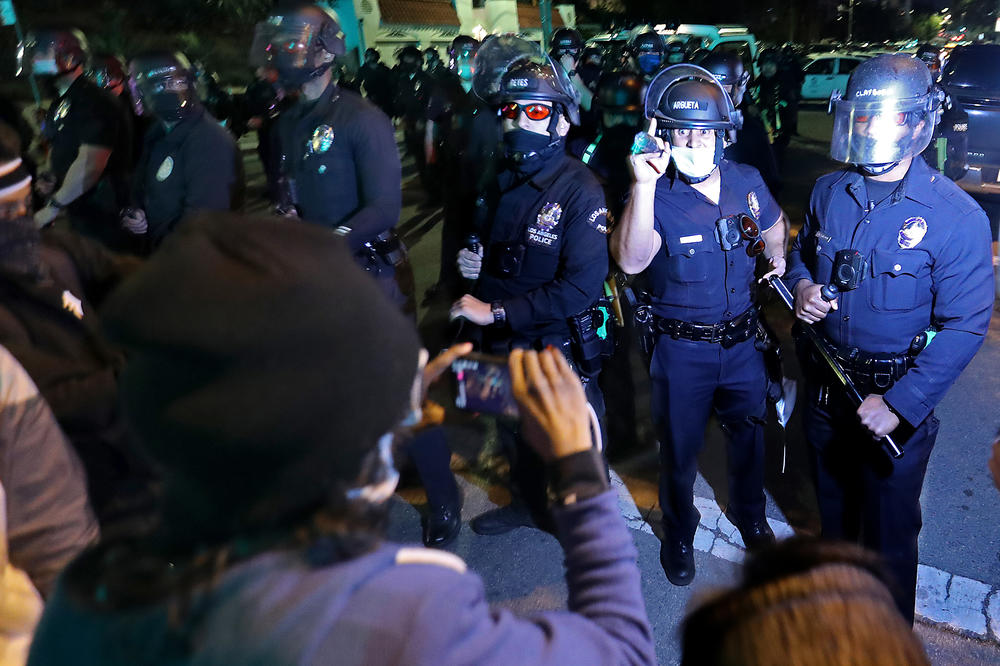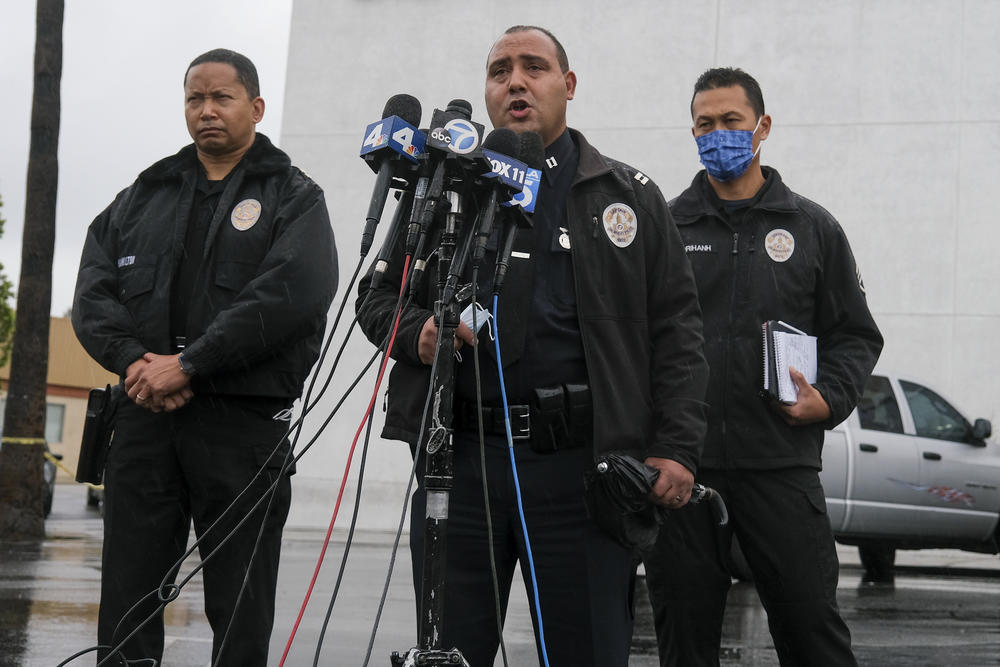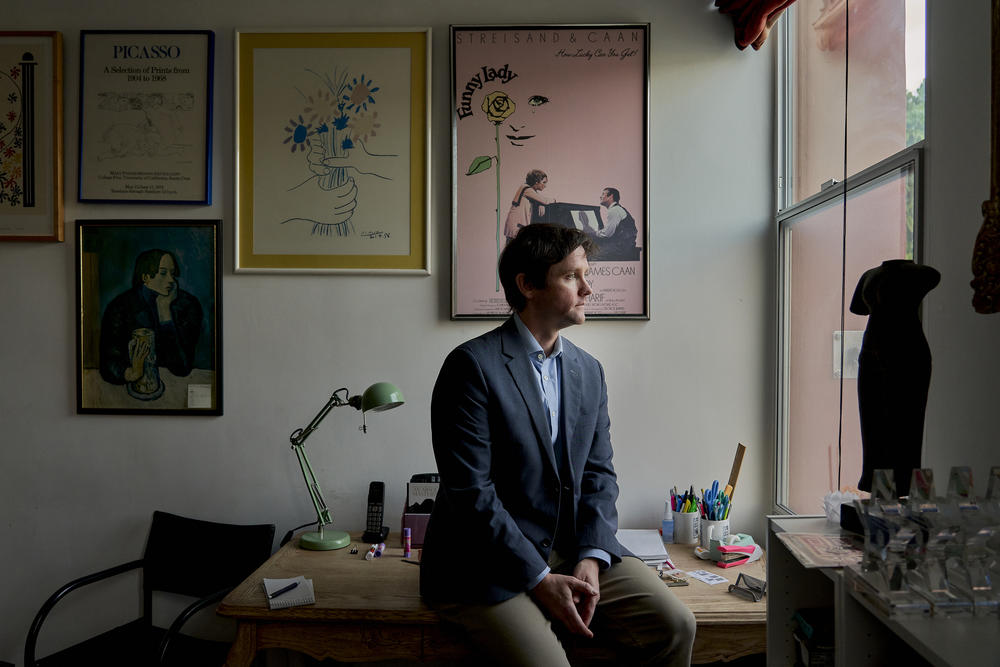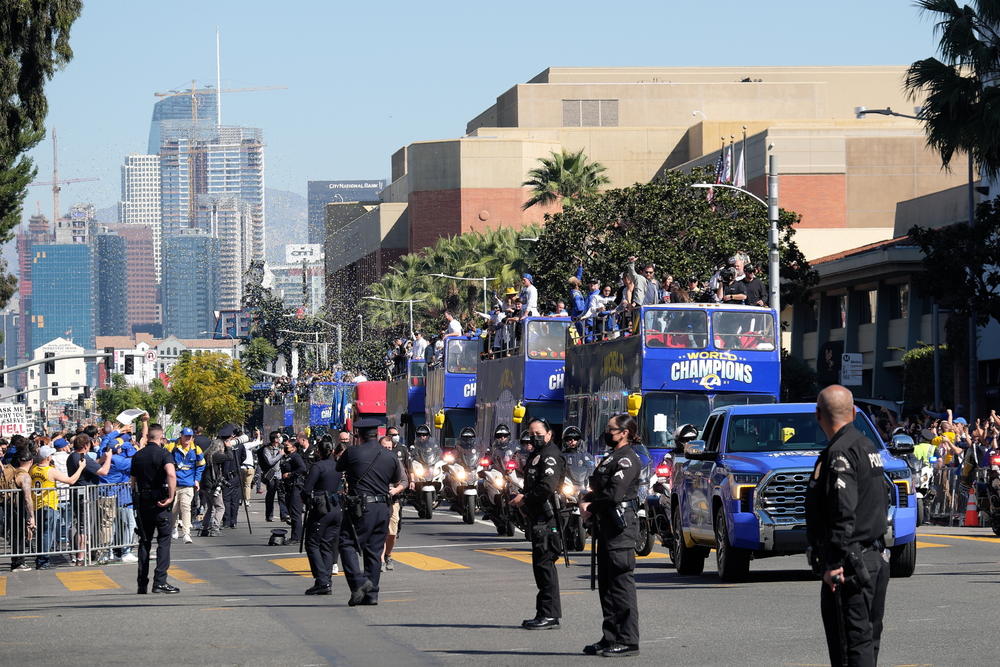Loading...
Section Branding
Header Content
When police cracked down on reporters on one chaotic night in LA's Echo Park
Primary Content
Bodycam footage shows police shooting rubber bullets at reporters. Smartphone videos capture police taking them into custody. Throwing them to the ground. Striking them with batons.
Over the past two years, 200 journalists have been arrested or detained while doing their jobs, right here in the U.S. Journalists have complained that police kept them far from the action, shut them down, even brutalized them and destroyed their equipment — in short, intimidated and prevented them from reporting.
One night of chaos in Los Angeles stands out, however, both for illustrating the collapse of the relationship between these two powerful institutions — the police and the news media — and for helping to spark reforms in California.
A year ago this month, as police prepared to sweep Echo Park Lake of homeless encampments, protests broke out. The reporters who descended on the scene to record it were caught in the middle, as police were unable or unwilling to distinguish between reporters and activists.
According to press advocates, police detained at least 16 journalists. Two reporters and an independent news blogger were arrested and held at a police station for hours. Two other reporters were zip-tied at the scene. Officers shot two photojournalists with what are called less-lethal rubber bullets.
The Los Angeles Police Department is facing legal challenges stemming from officers' actions that night and would only address in broad terms how it treats the press.
While it's important for the police to permit journalists to do their jobs, says LAPD Capt. Stacy Spell, the commanding officer of the force's media relations team, that's far from the department's only priority.
"When we're looking at situations where there is either civil unrest or protest or after sporting events, our greatest concern is ensuring that there is preservation of life and that there's preservation of property," Spell tells NPR. "It's very gray at times as to who's out there and with what intentions."
Others outside the LAPD don't mince words about Echo Park.
"It was a disaster for the police department," says former LA Police Department Deputy Chief Michael Downing, a former head of counterterrorism and special operations for the department. "These are not our enemies."
For some of the journalists who were at Echo Park, the actions by police served as confirmation that law enforcement could not be trusted. For others, it revealed the erasure of whatever respect — or at least guarded recognition — they believed police had for the work they did.
Here are some of their stories.
Luis Sinco, photographer for The Los Angeles Times: shot by rubber bullets
Luis Sinco, 62, says his photo assignments for The Los Angeles Times have allowed him to travel repeatedly to the crossroads of history. He has captured the fight for Fallujah in Iraq and the downfall of Libya's Moammar Gadhafi. In a chaotic moment, Sinco says, he has two imperatives: to take compelling pictures and to get out safely.
Echo Park's striking views of downtown Los Angeles often draw camera crews for nationally televised sports events. The lake offers visitors swan-shaped paddle boats, a concession stand, picnic tables, playgrounds and abundant wildlife around an artificial lake more than a century old.
During the pandemic, however, Echo Park became a haven for people without homes. An encampment evolved into an unexpected community, residents declared, affording vegetable gardens, makeshift plumbing and enduring social ties. It was more like a dystopia, according to its critics, feeding violence, drug use, trash and crime, and stripping the park of its recreational purpose for people living nearby.
On March 23, 2021, the Los Angeles Times revealed previously secret plans to clear the park. The city council member who represents the area and local social service agencies promised to provide transitional housing and social services. (Advocates for those displaced argued the initiative had mixed success at best.)
Over the next two days, activists descended upon the neighborhood, some chanting, some cheering, others fanning out to offer assistance or organize resistance.
When Sinco arrived on March 25, 2021, he saw protesters and police haranguing each other at the northern lip of the park over plans to remove the homeless people at the encampment. Police had tried to force reporters to a staging area a block to the west. Sinco wanted to be closer to the action to capture it all.
Late that evening, Sinco says, he was shooting photos from behind a trio of demonstrators when he heard a loud POP. A videographer tweeted out a video of what happened next: a police officer firing into a throng that was making no effort to move toward the officer.
In the video, it's easy to recognize Sinco as a news photographer: He holds a camera. A camera bag is slung around his neck and chest. The rubber bullet grazes the side of Sinco's leg. Sinco can be seen limping away.
"Sadistic," says Sinco, who says he was only mildly injured that night. "What was the point of that, right? I mean, it could have hurt me more badly. Thank God it didn't."
It wasn't the first time Sinco was struck by rubber bullets. On May 30, 2020, in protests in downtown LA over the murder of George Floyd, police shot Sinco with rubber bullets that destroyed his camera and left him with painful bruising.
Sinco says protesters can prove menacing, but adds, "I think that [police] are trying to treat the American public now as more like an occupied population. You see it more as a military presence in some ways."
Christian Monterrosa, freelance photographer: wounded by rubber bullets
Given Los Angeles' longstanding struggles to address homelessness, Christian Monterrosa, 29, saw news value in the protests breaking out at Echo Park. He didn't think he would be in danger; he left his bulletproof vest at home.
As the evening wore on, the freelance photographer got caught up in a kettling, which is what happens when police surround and detain people en masse. Monterrosa flashed his press pass and eased out of detention.
He then began to photograph protesters getting increasingly hostile. Some moved dumpsters to block themselves off from riot police in a nearby alley.
Police shot Monterrosa with two 40 mm rubber bullets from less than 10 feet away as they confronted the protesters. The shooting was documented by police body camera footage. A photo taken hours later shows it left a deep, round bruise about the width of a baseball on his abdomen, a location that can prove fatal, according to some law enforcement guidelines.
Monterrosa can be seen on the bodycam video wearing a press identity badge on a lanyard around his neck. He was taking pictures when he was shot. Police contend that Monterrosa walked into the way of bullets intended for a protester. Monterrosa who has freelanced for The Associated Press and The New York Times, has covered chaotic events including the Jan. 6, 2021, siege on the U.S. Capitol. He tells NPR he is not convinced that the LAPD's version of events is true.
In a ruling in a lawsuit from the LA chapter of Black Lives Matter challenging police use of force, a federal judge noted that the protester who police said was the target of the bullets that hit Monterrosa had been retreating from officers when the shots were fired. The woman posed little to no threat at the time. The judge pointed to the officers' firing of the 40 mm rubber bullets at Monterrosa as a likely violation of constitutional protections against excessive force.
"It was a classic example of the cops being upset that this group of people was not listening to what they were saying," Monterrosa tells NPR. "Everybody, everybody points to Echo Park now, to reference how bad things have gotten."
Kate Cagle, reporter for Spectrum News 1: detained by police
Kate Cagle, a reporter for the local all-news channel Spectrum News 1, says she had expected the police to let her do her job that night in Echo Park.
"The last time I had been at a protest, LAPD officers had actually escorted me into the area where the unlawful assembly had been declared so we could cover the mass arrests," says Cagle, who is 34. "I wear my credential. My crew has professional equipment. So I fully expected to be allowed to leave right away and was shocked when we were told we couldn't leave."
Instead, Cagle's camera crew recorded her being taken into custody just as she was about to go live on her station's newscast.
"You have my name," Cagle can be heard telling police on her station's video as officers whisked her away. She gestured back toward the camera. "I have to stay with my crew. I have to stay with my crew."
Officers instead detained Cagle for more than an hour, according to a later police review; for part of that time, her hands were zip-tied behind her back.
Cagle says that until that point, she had believed that the police would respect her professionalism even during moments of upheaval.
"I no longer felt like they were providing safety for me," Cagle tells NPR. "I felt like we're on our own."
Cagle, who is white, says she appreciates the attention her handling has received, but says Black and Latino reporters in Los Angeles are more likely to face rougher treatment.
James Queally, reporter for The Los Angeles Times, and Lexis-Olivier Ray, reporter for LA Taco: detained by police
Reporters cover protests and riots all the time; authorities often give them latitude to document what is taking place as it happens. The Los Angeles Times' James Queally had initially been allowed into the protests, past police lines at the rim of the park, after flashing his LAPD-issued press credentials.
Queally, who is 34, reports on criminal justice for the Times and is the son of a retired New York City police detective. He says he was shocked that officers started to round up journalists too after telling the crowds the gathering was illegal.
"In the past — at least in my experience covering protests — that has not applied to media," Queally says.
At Echo Park, when officers ordered protesters to disperse, Queally and some other reporters once more assumed it would not apply to them. Police later said officers specifically used a bullhorn to warn members of the media and legal observers that they needed to leave, about 35 minutes after the initial order; Queally says he didn't hear it and tweeted later that night that protesters were starting to leave when they were penned in by police.
Police had detained Queally once before, while he was covering an anti-Donald Trump protest in LA in 2016. He says he showed his press card to senior officers. "They let me out, because they probably thought better of arresting a Los Angeles Times reporter," he says.
Not at Echo Park. Police zip-tied Queally's hands and left him that way for more than an hour. As he had five years earlier, Queally said he told a sergeant that he was a reporter. According to Queally's account to his own newspaper, the senior officer replied, "Yes, this is the policy tonight."
Queally had stuck close to fellow reporter Lexis-Olivier Ray, of the news and food-culture site LA Taco, most of the night. Ray posted a video of police in riot gear hauling Queally away.
Queally credits Ray's tweets for his ultimate release. Kevin Rector, a police reporter for the LA Times, and others at the newspaper hit the phones, seeking Queally's release. Ray, who was not zip-tied, was detained by police for longer than Queally.
Just the week before, Queally and Rector had written about Ray's own encounter with police. Ray, who is 32, was LA Taco's first full-time reporter, a photojournalist who had turned over the previous few years to writing articles about law enforcement, housing and homelessness.
Back in October 2020, Ray had covered the rowdy crowds celebrating the Dodgers' World Series victory in downtown LA. Police declared the gathering unlawful and ordered fans to disperse.
A scrum of police officers rushed Ray, shoving him to the ground and appearing to strike him. On Twitter, Ray said police beat him with batons and broke the top of his video camera. On a video he tweeted out, Ray can be heard repeatedly identifying himself as a "member of the press."
Ray was not charged at the time. Yet in February 2021, Ray became the only person of the hundreds at the raucous celebrations against whom the LAPD sought criminal charges of failure to disperse. Ray says a city attorney warned him charges could be revived if he had future violations. The city attorney involved did not return NPR's request for comment.
NPR has reviewed a May 2021 draft memo about events at Echo Park that was circulated inside the LAPD, and confirmed by LAPD's top spokesman. In it, Ray was described as having engaged in conduct at demonstrations "that blurs the lines between functioning as the press v. functioning as an activist."
Ray bristles at that characterization.
"It's completely false," Ray tells NPR. "I've never even been to a protest as a protester. I don't consider myself to be a protester. And that was really frustrating — it really, really rubbed me the wrong way."
He says he has never applied for an LAPD-issued press pass. It's not required, either by law or police procedures, for reporters who cover law enforcement.
Ray is Black. He thinks police are responding to his race, the informal way he dresses — Ray often wears a bright red cap emblazoned with the LA Taco logo atop his Afro — and the way he carries himself.
"A lot of times it feels like the cops don't believe that I'm a reporter," Ray says. "I do try to go out of my way to be professional and to treat police officers with respect when I'm doing my job. I'm never yelling things or throwing things or getting in the way intentionally."
The LAPD's Capt. Spell, who is also Black, later called Ray to try to put their relationship on a more solid professional footing. Neither emerged fully satisfied, though Ray says he thought Spell's effort to connect was sincere. The reporter declined Spell's efforts to meet in person.
After Echo Park and all that led up to it, Ray says, he is still shaken and still wary of police. Leaving the house to go out to report is, he says, "a little bit scary for me, that's for sure."
Police cite trouble distinguishing reporters from activists
Now, stop to consider the challenges confronting the LAPD by March 2021 as it encountered the press at Echo Park.
First, recognize the nature of the protests themselves.
"However noble their aims might be, when they get in the face of police, they're cursing them out," says the LA Times' Queally of many protesters. Sometimes, he says, such interactions become even more intense: "They're insulting them on a personal level. They're [making] comments about officers' weight. Often you'd see officers that were not white accused of being 'race traitors'."
The LAPD is 50% Latino, according to department figures. Another 9% are Black and 10% are Asian American, including Filipino Americans.
"I'm not saying that validates any sort of force reaction," Queally says, but adds protesters are "not exactly looking for a warm, peaceful conversation."
NPR unsuccessfully sought comment from several current police officials about what happened at Echo Park, including a commanding officer present that night, an internal affairs officer involved in investigating complaints about the use of police force, and the LAPD's top civilian official, who oversees its legal policies. NPR also sought without luck to track down other police officers who were there. And LAPD Chief Michel Moore declined NPR's request for an interview, through his spokesman.
Capt. Stacy Spell joined the LAPD in 1994 after a stint in the U.S. Army. He worked in homicide, gangs and internal affairs before becoming the head of the LAPD's communications division in August 2020. Citing litigation and other challenges to the department's behavior at Echo Park, Spell says he could only speak to NPR in general terms.
He says recent protests have occurred against the backdrop of the pandemic and allegations of police misconduct nationwide, as well as in Los Angeles.
"There were tensions upon tensions," Spell tells NPR. Tensions, he says, that can test police officers' patience. But, he insists, "Overall, I think most of our officers engaged in the most professional way that they could under the circumstances."
While the First Amendment does not expressly grant privileges to a special class of professionals called journalists, it protects the rights of people who are doing journalism. Until this year, California state law was ambiguous on reporters' right to be in public spaces during upheaval. Police interpreted the laws to say dispersal orders applied to journalists too.
"Arguably you could have five attorneys look at one law and have different interpretations," Spell says. "It's particularly more challenging for officers who are on the ground and are dealing with the situation as it's volatile and ongoing."
Today anyone with a mobile phone can be a videographer. Police who regularly wave reporters past cordoned-off protest lines now tell their bosses that they have trouble determining who genuinely is a reporter. Several news-making videos of police misconduct were taken by eyewitnesses who are not reporters. In 2021, the Pulitzer board awarded a special citation to Darnella Frazier, the teenager who videotaped the murder of George Floyd.
"Once upon a time there was a very traditional look as to what the media looked like," Spell says. "And now there are more independents and more people who post on social media or online or use some form of technology to express their views or their points or their stories."
Capt. Stacy Spell: Proving a point with a card trick
Spell has a kind of card trick he plays with visitors to his offices at LAPD headquarters in downtown LA. He unbuttons the pocket beneath his badge and pulls out a fistful of laminated cards that he lays out, one after another, face up on the table. "I carry these cards with me just about everywhere," Spell says.
The cards are press passes from the National Press Photographers Association and other professional journalism groups. All of the cards carry Spell's full name and photo. He says none of the groups conducted a background check to confirm whether he is truly a journalist.
"If anybody can order something online, and as long as your check clears, then that now makes you a journalist, it doesn't mean that you're going to follow certain ethical standards," Spell says. "Bottom line is, we want to make sure people are safe."
Spell says he has put a premium on developing professional working relationships with news outlets since taking over the press shop in August 2020.
And the LAPD encourages reporters to get official press credentials through the department that would allow reporters more freedom of movement, because police would know which newsrooms and which news executives to contact if troubles arose. The department says it honors press passes from the sheriff's department and from other cities too.
Most cities in California do not issue such formal credentials. And there's no requirement that reporters get them, as a deputy LAPD chief acknowledged in a memo circulated to staff in October 2020. Under the First Amendment, no one needs to be credentialed to act legally as a journalist.
That memo states police are supposed to honor any credential showing someone is a journalist, or even any verbal claim of it, as long as they are acting lawfully. For those who have sought such press passes, the wait has been arduous; the department has attributed a months-long backlog to software problems.
Police argue that some self-described journalists clearly act unprofessionally. One self-described "gonzo" reporter in LA who asks police spokespersons for information in emailed queries often joins protesters in taunting officers on the street, according to other reporters. Another gadfly who works in finance frequently posts videos on Twitter documenting possible police misconduct; his arrest last fall brought cries of retaliation.
The governor makes a U-turn on press rights
Over the past two years, the U.S. Press Freedom Tracker and other journalism advocacy groups have charted an increase in what they say is repressive police violence toward journalists across the country. Numerous journalists in Minneapolis were tear-gassed and shot with projectiles by law enforcement during protests over George Floyd. Federal prosecutors are investigating whether police in Louisville, Ky., and Phoenix, Ariz., have interfered in protected First Amendment activities of journalists and others present, according to a U.S. Justice Department spokesperson.
Yet events in Los Angeles stand out.
A statewide database of incidents compiled by Adam Rose, a former news editor who leads the Los Angeles Press Club's press rights committee, reflects dozens of such incidents along the way, especially in greater LA.
"The point of a free press is really to inform the public of, in particular, things of great public interest, like police actions," Rose says. "These are things that would chill what we would consider part of this constitutional right and the need — not just a right, but a responsibility — to inform the public."
On Sept. 30 2020, California Gov. Gavin Newsom vetoed a bill that would have made it clear reporters have the right to be present in public spaces to document protests, civil uprisings and arrests.
The bill was heatedly opposed by several law enforcement groups. In a letter to lawmakers explaining his veto, Newsom affirmed the importance of news gathering, but added he was concerned people who could pose a security risk could gain access to restricted areas — including white nationalists and extreme anarchists.
After Echo Park, front-line reporters added their voices to newspaper companies and First Amendment groups to lobby for those protections. And in October 2021, the governor signed a strengthened press rights bill into law. No longer could police claim orders to disperse at protests and other civil disturbances applied to working journalists.
"Normally journalists don't lobby," says Rose. "That's not part of the job of journalism and it's often the wrong thing to do." In this case, he said, their advocacy for their ability to do their jobs helped reshape public policy.
An early test of the new law came in February at the parade celebrating the LA Rams' Super Bowl win. Reporters gave the LAPD fairly strong marks for letting them document the parade and for allowing the "staging area" to float along with the day's festivities, rather than staying fixed in a single isolated spot.
Journalists tell NPR they're heartened. But they remain wary, with strong memories of Echo Park.
Copyright 2022 NPR. To see more, visit https://www.npr.org.
